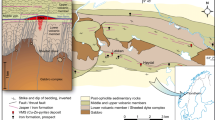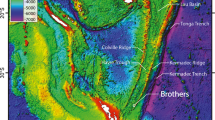Abstract
The hydrologic structure of Taal Volcano has favored development of an extensive hydrothermal system whose prominent feature is the acidic Main Crater Lake (pH<3) lying in the center of an active vent complex, which is surrounded by a slightly alkaline caldera lake (Lake Taal). This peculiar situation makes Taal prone to frequent, and sometimes catastrophic, hydrovolcanic eruptions. Fumaroles, hot springs, and lake waters were sampled in 1991, 1992, and 1995 in order to develop a geochemical model for the hydrothermal system. The low-temperature fumarole compositions indicate strong interaction of magmatic vapors with the hydrothermal system under relatively oxidizing conditions. The thermal waters consist of highly, moderately, and weakly mineralized solutions, but none of them corresponds to either water–rock equilibrium or rock dissolution. The concentrated discharges have high Na contents (>3500 mg/kg) and low SO4/Cl ratios (<0.3). The Br/Cl ratio of most samples suggests incorporation of seawater into the hydrothermal system. Water and dissolved sulfate isotopic compositions reveal that the Main Crater Lake and spring discharges are derived from a deep parent fluid (T≈300 °C), which is a mixture of seawater, volcanic water, and Lake Taal water. The volcanic end member is probably produced in the magmatic-hydrothermal environment during absorption of high-temperature gases into groundwater. Boiling and mixing of the parent water give rise to the range of chemical and isotopic characteristics observed in the thermal discharges. Incursion of seawater from the coastal region to the central part of the volcano is supported by the low water levels of the lakes and by the fact that Lake Taal was directly connected to the China sea until the sixteenth century. The depth to the seawater-meteoric water interface is calculated to be 80 and 160 m for the Main Crater Lake and Lake Taal, respectively. Additional data are required to infer the hydrologic structure of Taal. Geochemical surveillance of the Main Crater Lake using the SO4/Cl, Na/K, or Mg/Cl ratio cannot be applied straightforwardly due to the presence of seawater in the hydrothermal system.
Similar content being viewed by others

Author information
Authors and Affiliations
Additional information
Received: 12 February 1997 / Accepted: 26 January 1998
Rights and permissions
About this article
Cite this article
Delmelle, P., Kusakabe, M., Bernard, A. et al. Geochemical and isotopic evidence for seawater contamination of the hydrothermal system of Taal Volcano, Luzon, the Philippines. Bull Volcanol 59, 562–576 (1998). https://doi.org/10.1007/s004450050210
Issue Date:
DOI: https://doi.org/10.1007/s004450050210



